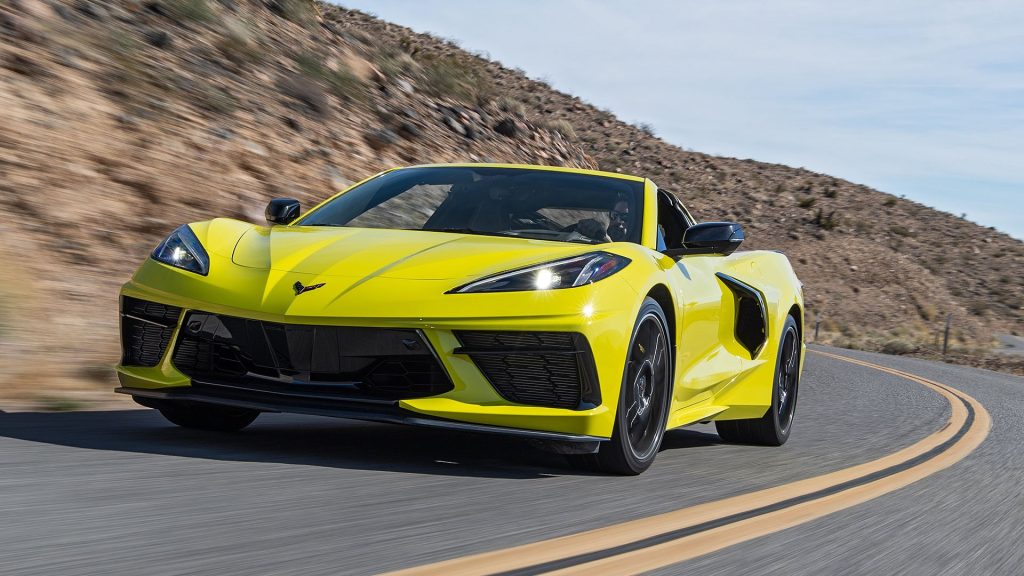The Chevrolet Corvette has long been an icon in the world of sports cars, known for its powerful performance, distinctive design, and relatively affordable price in comparison to other exotic cars. For over six decades, the Corvette has been a symbol of American engineering excellence, blending cutting-edge technology with raw power. However, when the C8 Corvette was revealed in 2019, it marked a monumental shift for the legendary nameplate—one that would send shockwaves through the automotive world.
For the first time in Corvette history, Chevrolet broke away from its traditional front-engine layout and embraced a mid-engine design. The C8 Corvette, introduced as the 2020 model, now features an engine placed behind the driver and passenger, in a configuration traditionally associated with high-performance supercars from manufacturers like Ferrari, Lamborghini, and Porsche. This radical change raised a key question: Can the mid-engine design of the Corvette C8 truly change the sports car market? In this article, we’ll explore how this new design impacts the Corvette, its competitors, and the broader sports car landscape.
1. A Brief History of the Corvette’s Engine Layout
Before the introduction of the C8 Corvette, the Corvette’s identity had been tied to its front-engine, rear-wheel-drive layout. Since its debut in 1953, the Corvette maintained its distinctive engine position, with the V8 engine positioned in the front of the car, sending power to the rear wheels. While this layout worked well for decades, enabling the Corvette to balance performance with relative affordability, it was always considered “conventional” in the world of high-performance sports cars.
Mid-engine designs, on the other hand, have been a hallmark of high-end performance vehicles, offering better balance, handling, and responsiveness. Many of the world’s most renowned supercars, such as the Ferrari 488, Porsche 911 GT2 RS, and McLaren 720S, utilize this configuration for optimal performance. The mid-engine layout places the engine closer to the center of the car, improving weight distribution and handling dynamics. It also lowers the center of gravity, which enhances the car’s ability to navigate corners with precision and agility.
For decades, enthusiasts and critics alike speculated whether the Corvette would ever make the leap to mid-engine. In 2020, that leap was officially made with the unveiling of the C8 Corvette, a car that would forever change how we think about American performance cars.
2. Why the Mid-Engine Design?
The decision to make the Corvette a mid-engine sports car was not just a marketing gimmick but a strategic move to improve performance and take on the best in the business. Let’s examine the reasons why the mid-engine layout was so significant:
Improved Handling and Performance
- Weight Distribution: The mid-engine design allows for a more even weight distribution, with the engine positioned closer to the center of the car. In contrast, front-engine cars like the previous Corvette models tend to have more weight at the front, making them less agile in corners. The C8 Corvette’s weight balance is much more optimal, giving it better cornering capability, agility, and stability at high speeds.
- Lower Center of Gravity: By lowering the engine’s position in the chassis, the C8 benefits from a lower center of gravity, which improves its overall handling dynamics. A low center of gravity allows the car to remain planted on the road, reducing body roll and improving stability during hard cornering and acceleration.
- Aerodynamics: With the engine placed centrally in the car, the C8 Corvette has better aerodynamics. The streamlined design, paired with the engine’s position, enhances downforce, which improves traction at high speeds and during aggressive cornering.
Enhanced Driving Experience
The mid-engine layout of the C8 Corvette transforms the driving experience by providing more precise steering feedback, faster response times, and an overall more engaging ride. Whether on the track or winding roads, the C8 provides a driving experience that’s closer to high-end supercars, but at a fraction of the cost. This is a significant leap forward in terms of performance dynamics for Chevrolet, bringing the Corvette closer to the performance standards set by European and exotic manufacturers.
3. Impact on the Sports Car Market
The introduction of the mid-engine C8 Corvette has had a ripple effect throughout the sports car industry. The Corvette has long been considered an affordable alternative to European sports cars, providing impressive performance without the astronomical price tag. The shift to a mid-engine layout only strengthens this positioning.
A Serious Challenge to European Rivals
By adopting the mid-engine design, the C8 Corvette now competes directly with some of the most prestigious names in the sports car market. Vehicles like the Porsche 911, Ferrari F8 Tributo, and Lamborghini Huracán have long been considered the benchmark for high-performance cars. The C8 Corvette’s combination of affordable pricing, American engineering, and supercar-like performance makes it an incredibly compelling alternative to these European models.
- Price-to-Performance Ratio: The most striking aspect of the C8 Corvette is its price. While the base model starts at around $60,000, it offers performance figures that rival much more expensive vehicles. The C8’s 6.2-liter V8 engine, which produces 495 horsepower and 470 lb-ft of torque, allows it to accelerate from 0 to 60 mph in under 3 seconds—an impressive feat for any sports car, let alone one priced so competitively. In comparison, a Porsche 911 Carrera starts at a significantly higher price point, with a base price around $100,000.
- Shift in Perception: Historically, American sports cars like the Corvette have often been considered brute-force vehicles, focusing on raw power rather than refined performance. With the C8, however, Chevrolet has redefined the Corvette’s image, transforming it from an affordable muscle car to a genuine contender in the supercar category. The mid-engine layout places it on equal footing with some of the most revered names in the industry.
Shifting the American Performance Car Paradigm
For decades, American performance cars, especially those from Chevrolet, have been associated with the front-engine, rear-wheel-drive formula, which works well for creating muscle cars with straight-line speed. However, this formula has always had limitations when it comes to handling and overall performance on twisty, technical roads or racetracks.
The mid-engine Corvette now sets a new benchmark for American sports cars, proving that a performance car built in the U.S. can not only compete with European rivals but can also innovate in ways that challenge industry norms. The C8 Corvette signals a shift in the American automotive landscape, with Chevrolet now setting its sights on building cars that offer precision handling, advanced aerodynamics, and world-class performance—not just straight-line speed.

4. The C8 Corvette’s Performance and Technology
One of the standout features of the C8 Corvette is its remarkable performance and the advanced technology it brings to the table:
- Performance: The C8’s V8 engine produces 495 horsepower and 470 lb-ft of torque in the base model, while the Z51 performance package further enhances the car’s performance. The car’s mid-mounted engine, combined with an 8-speed dual-clutch transmission, provides lightning-fast gear shifts and optimal acceleration. The C8’s 0-60 mph time of under 3 seconds places it in the same league as many exotic supercars, but with a price tag that’s far more accessible.
- Handling: Thanks to its new mid-engine layout and adaptive suspension system, the C8 Corvette offers exceptional handling. Whether you’re on a twisty mountain road or at the track, the car’s precision steering and balanced chassis allow for sharp turns and quick responses, making it an exhilarating car to drive.
- Technology: The Corvette C8 is equipped with cutting-edge technology, including an advanced infotainment system, driver-assistance features, and a heads-up display. The car also includes a digital cockpit, offering a modern and futuristic feel that enhances the overall driving experience.
5. Will the Mid-Engine Corvette Transform the Sports Car Market?
The C8 Corvette is undeniably a game-changer in the sports car world. By adopting the mid-engine layout, Chevrolet has taken a bold step in redefining its iconic Corvette brand and challenging the European dominance in the performance car market. The Corvette now competes directly with some of the most coveted names in the industry, such as Porsche, Ferrari, and Lamborghini—yet at a price point that remains remarkably affordable.
Chevrolet’s focus on delivering supercar-like performance and world-class handling at an accessible price has put the Corvette on the map in a way that it has never been before. For many enthusiasts, the C8 Corvette may just be the best value in the sports car market today. Its combination of aggressive styling, exceptional performance, and mid-engine handling makes it a formidable challenger to high-end European competitors.
Whether the mid-engine Corvette can completely transform the market depends on how Chevrolet continues to evolve the car and how the broader sports car landscape reacts. However, the C8 Corvette is undoubtedly a game-changer in the world of performance cars, and its impact on the industry is likely to be felt for years to come.
In conclusion, the mid-engine design of the Chevrolet Corvette C8 has the potential to reshape the sports car market, challenging traditional European dominance and setting a new benchmark for what an affordable, high-performance car can achieve. For fans of American engineering and sports cars, the C8 Corvette is a triumphant moment, proving that innovation and performance don’t have to come with an astronomical price tag.


































Discussion about this post